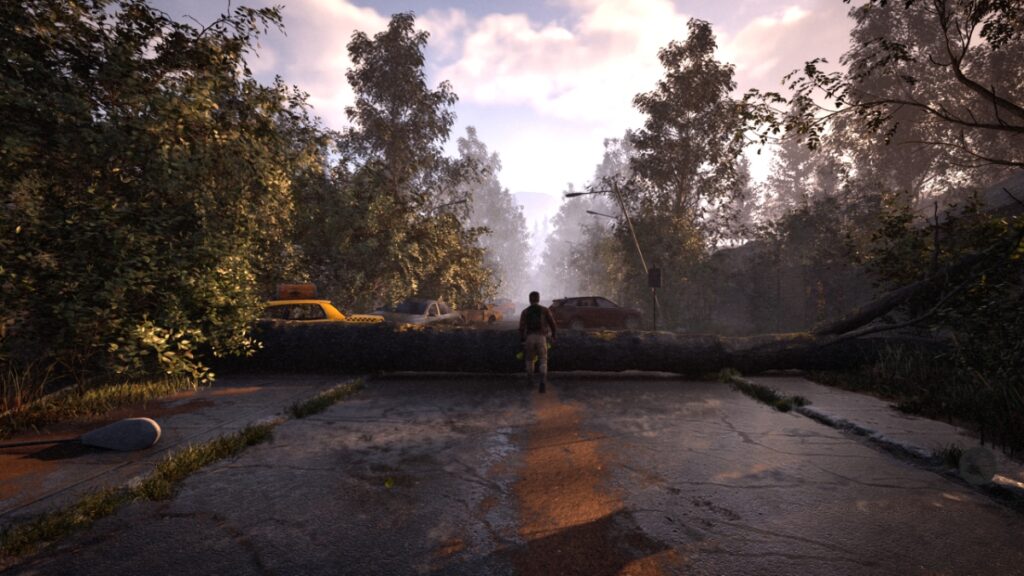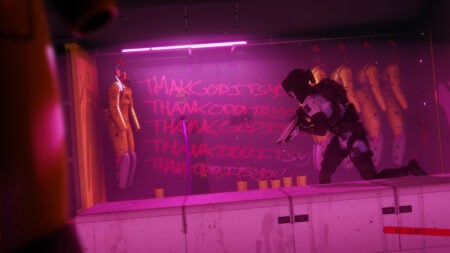Skip To...
Some call them Death Angels, others Listeners. They came from the stars, blind but indestructible. Every broken twig and creaking door summons them, aliens drawn to the sound of prey. Set in the world of the 2018 film starring Emily Blunt and John Krasinski but following original characters, A Quiet Place: The Road Ahead is a stealth action game about staying quiet. It might’ve been better if that’s all it tried to be. Instead, The Road Ahead reaches for an empathetic story as nuanced as the original, only to grasp air.
A Quiet Place: The Road Ahead Review

Armor-plated and massive, the Listeners are invulnerable to harm. They’re faster than you, too, so you can only hide or distract. A Quiet Place: The Road Ahead is a stealth game set in a handful of linear environments, challenging you to collect supplies, solve simple environmental puzzles, and avoid the Listeners. The Road Ahead will even detect your mic sounds (if you enable that option), meaning one scream or anxious laugh could be your last. Though the game produces some tense encounters, its limited mechanics and clumsy story struggle to translate the movie’s anxiety-gnawing atmosphere.
Story: The Music of the Grave

The Listeners arrived on meteorites and promptly hunted most humans to extinction. They were too tough and too fast, and society fell. Its remnants survive in scattered bunkers and basements, soundproofed with thick doors, mattresses, and newspaper: anything that’ll deaden the sound and keep the Listeners from noticing. It’s more fearful than most apocalyptic fiction, and A Quiet Place: The Road Ahead does a great job of establishing dread with its opening act. Alex and her family are struggling, as Mark (the leader of their outpost) cuts back rations and closes his fist in a bid to retain control of the fragile group.
When events force Alex to abandon the relative safety of the bunker and strike out upon the road, her family drama follows. One of The Road Ahead‘s biggest missteps is its eagerness to abandon the bunker and get the action underway. In an attempt to eat its dehydrated apocalypse beans and have them too, the plot sends Alex into the wild while shoehorning in NPCs and cutscenes to continue the domestic drama. This breaks the pacing of both the horror and family plots in a way the story never recovers from.

Krasinski’s film succeeded as both a human drama and a creature feature. Caring for children, including a deaf daughter, created tremendous emotional tension in an environment where every sound inches you toward death. The Road Ahead wants to explore the repercussions of loss and trauma on individuals and families, but that’s an ocean-deep subject, and this game has only a puddle to spare. As much as it succeeds as a stealth game, it fails as a narrative. Despite some cheap tugging of heartstrings, neither the writing nor the performances compelled me to care about Alex and the others.
There are a few moments of genuine human tenderness here, well-written and well-performed, but they have been dragged out to sea by a riptide of crude exposition. Story beats arrive too abruptly, their dramatic shifts unearned. The main cast just doesn’t get enough time on stage before they’re shoved into monologues we’re supposed to care about but can’t. It’s not rushed so much as weirdly clipped and spliced. As someone who found the humanity of Krasinski’s film one of its best features, I’m disappointed.
Gameplay: Hide and Speak

Look at the floor beneath you. Is it tile? Old wood? What sound does it make when you take a step? If a gigantic, armored alien were listening, would it hear you before you made it to the nearest door? The horror inherent in that simple premise is the strongest part of A Quiet Place: The Road Ahead. Crouch, creep, and watch where you step. One loose can or piece of broken glass can be the death of you. In most horror games, the ground matters as little as the sky. Here you’re eyeing it at all times, looking for a patch of sand to muffle you or a puddle that might give you away.
The blindness and keen ears of the Listeners allow for creative stealth encounters. Sightlines don’t matter; surfaces do. Bear traps and noise traps rigged by other survivors require decisive action to avoid and disable. The Listeners are never far, and although the lowest difficulty trivializes most encounters, higher difficulties are much nastier. That’s as it should be, but much of the game’s difficulty arises from the Listeners’ spotty noise detection and AI. Alien: Isolation 2 this is not.

A phonometer displays the ambient noise and your own, allowing you to stay undetected. I love the tactile mechanic used to open doors, drawers, and grates: the slower you move, the less noise they make. Run or yank open a door, and you’ll typically be dead within seconds. Even by the standards of the stealth genre, this creates slow gameplay. You aren’t Sam Fisher with a fistful of gadgets: you’re a regular person with a glass bottle and a dream. It’s not the helplessness I object to; it’s the absence of creative choice during these slow moments. Your options are few, so it’s just a matter of waiting.
You collect notes and other items for a bit of worldbuilding. Sometimes you fetch a ladder or flip a switch to solve a straightforward environmental puzzle. More difficult is managing Alex’s asthma. Proximity to the creatures aggravates her lungs, as does spending time in dusty environments such as abandoned warehouses. You’ll need regular inhaler doses to keep Alex’s breathing in check, and the game does a great job of testing your resource management on the harder difficulties. This leads to some great, fraught moments, gaze flitting back and forth from your reddening lungs to the aliens hunting you.
Graphics & Audio: Difference and Distillation

The ladder you need is in the shed, but a noise trap blocks the path, its trip cord tied to empty cans, ready to clatter. Beyond it, there’s a shape, hulking and gray, like fog compressed amongst the trees. The Death Angel releases an insectoid chitter accompanied by a rising hum as it raises its head to listen. The lights of your phonometer jump, detecting your soft footfalls in the dirt. A shrill wind masked your approach, but now that you’re a few feet away from the trap, even the wind is holding its breath.
If you think The Road Ahead‘s audio design should be good for some Halloween chills, get yourself some candy corn and a pat on the back. You’re right. They’re also well-designed tells, cluing you into the creature’s activities or your clumsiness. If you want to know when to stop moving, watch and listen. Overall, it’s well-designed and well-executed, and I had no issues with the mic integration. Stealth sequences are much more immersive when you’re using a mic, but even without one, they’re tense. The difference between stepping on leaves, sand, and a mud puddle is huge, and it feels like it.

The Road Ahead gains a lot from its artful lighting. Whether in a rainstorm or during a calm summer day, environments feel much richer than they otherwise would. Safehouses are lush in detail and ambiance, but outdoor environments die on impact. Realism is an art style, but “make it look real” isn’t. The game never feels like more than the distillate of the last 100 post-apocalyptic settings. It doesn’t have its own personality, and so it can’t lend any to its characters.
The characters, already hamstrung, take an arrow to the knee from graceless exposition. The Road Ahead wants to push you from one set piece and stealth sequence to the next, character development be damned. That said, the ambient audio and SFX of the ranch, hospital, and beyond are great. Unfortunately, the life drains out as soon as someone starts talking. It’s mostly talented voice actors given an unfair shake by weak dialogue, but the result is a soundscape as taut and hollow as a bongo. It’s worth mentioning, I experienced few bugs and no crashes during my time with the game.
Conclusion: Dead Ends

The Road Ahead is a stealth horror experience that cares more about jump scares and crunchy leaves than it does about having believable humans do believable things. As a follow-up to the poignant and spooky original, it’s a disappointment, and I don’t need a phonometer to tell me the sound of missed opportunity is deafening here. You can take your first muffled steps with A Quiet Place: The Road Ahead on PC, PS5, and
Review copy provided by Publisher.
A Quiet Place: The Road Ahead (PC Reviewed)
A stealth game with engaging interaction mechanics and cool aliens, weakened by spotty AI and lackluster characters.
Pros
- Excellent, tactile interaction mechanics
- Some tense stealth sequences
- Great lighting
Cons
- Weak plot
- Flimsy dialogue and characterization
- Spotty enemy AI and pathfinding








